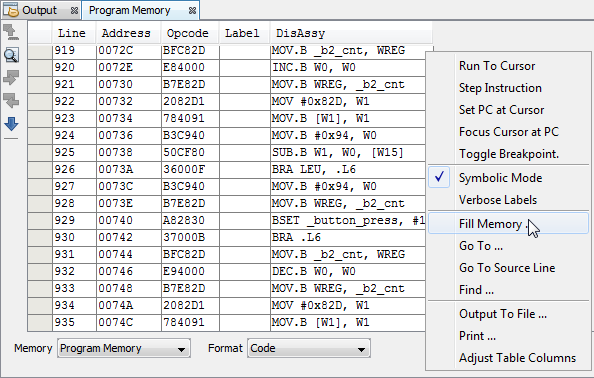You may specify how memory is displayed in the window by selecting
from the Format drop-down box on the bottom of the window.
When using a hardware tool for debug, some registers may show an “R”
for each nibble of data to represent a reserved resource.
Code Format
Code format displays disassembled hex code with symbols. The window
will have the following columns:
- Debug Info – Information useful for debugging
. A pointer shows
the current location of the program counter.
- Line – Reference line number.
- Address – Opcode hexadecimal address.
- Opcode – Hexadecimal opcode, shown in 2- or 3-byte blocks
For
most PIC MCUs, these blocks represent words.
For PIC18CXXX devices, the blocks
represent 2 bytes.
For dsPIC DSC devices, the blocks represent 3 bytes.
- Label (Symbolic Only) – Opcode label in symbolic format.
- Disassembly – A disassembled version of the opcode
mnemonic.
Hex Format
This format displays program memory information as hex code. The
window will have the following columns:
- Address – Hexadecimal address of the opcode in the next
column.
- Opcode Blocks – Hexadecimal opcode, shown in 2- or 3-byte
blocks
For most PIC MCUs these blocks represent words. For PIC18CXXX devices,
the blocks represent 2 bytes. For dsPIC DSC devices, the blocks represent 3
bytes.
The opcode block that is highlighted represents the current location of
the program counter.
- ASCII – ASCII representation of the corresponding line of
opcode.
PSV Mixed (dsPIC DSC/PIC24 devices only)
This format displays program memory as opcode and the PSV area
(CORCON register, PSV bit set). The window will have the following columns:
- Debug Info – Information useful for debugging. A pointer shows
the current location of the program counter.
- Line – Reference line number.
- Address – Opcode hexadecimal address.
- PSV Address – Data space hexadecimal address of the
opcode.
- Data – Opcode formatted as data.
- Opcode – Hexadecimal opcode, shown in 3-byte blocks.
- Label – Opcode label in symbolic format.
- Disassembly – A disassembled version of the opcode
mnemonic.
For more information, see the dsPIC30F Family Reference Manual
(DS70046).
PSV Data (dsPIC DSC/PIC24 devices only)
This format displays program memory as file registers, for when
program space is visible in data space (CORCON register, PSV bit set). The window
will have the following columns:
- Address – Program space hexadecimal address of the data.
- PSV Address – Data space hexadecimal address of the data.
- Data Blocks – Hexadecimal data, shown in 3-byte blocks
. The
highlighted data block represents the current location of the program
counter.
- ASCII – ASCII representation of the corresponding line of
data.
For more information, see the dsPIC30F Family Reference Manual
(DS70046).





